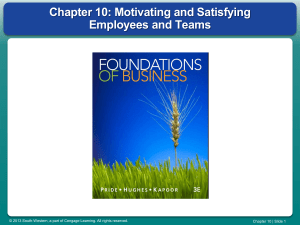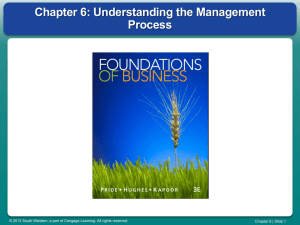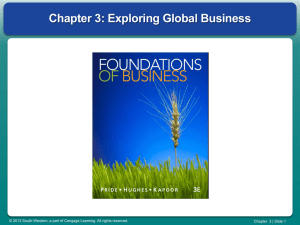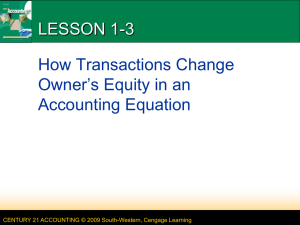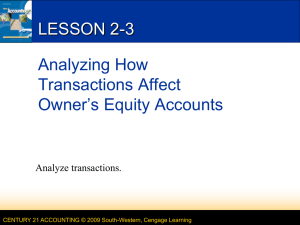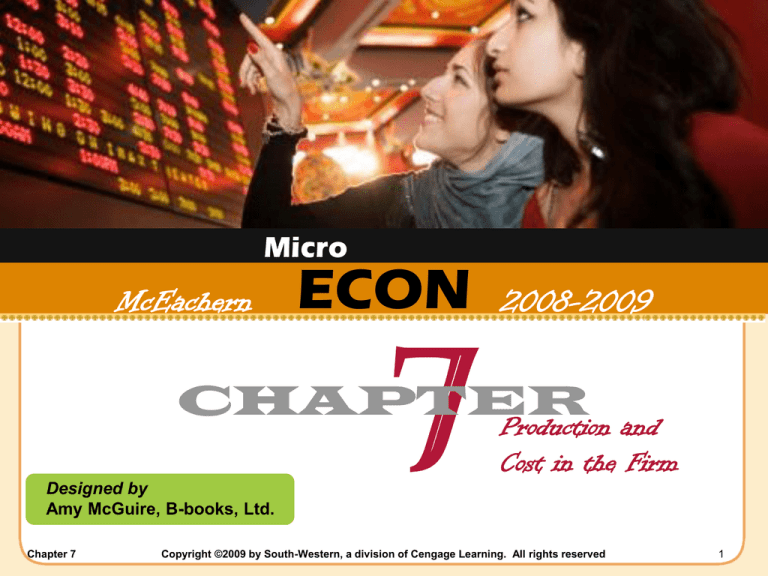
Micro
McEachern
ECON
7
2008-2009
CHAPTER
Production and
Cost in the Firm
Designed by
Amy McGuire, B-books, Ltd.
Chapter 7
Copyright ©2009 by South-Western, a division of Cengage Learning. All rights reserved
1
Cost and Profit
Producers: Maximize profit
Opportunity cost
– All resources have an opportunity cost
Explicit costs
– Payments for resources
Implicit costs
– Opportunity cost of resources owned
by the firm / firm owners
– No cash payment
1
LO
Chapter 7
Copyright ©2009 by South-Western, a division of Cengage Learning. All rights reserved
2
Alternative Measures of Profit
Accounting profit
– Total revenue minus explicit costs
Economic profit
– Total revenue minus all costs (implicit and
explicit)
• Opportunity cost of all resources
Normal profit
– “Accounting profit in excess of normal profit”
• Accounting profit = Economic + Normal profit
LO1
Chapter 7
Copyright ©2009 by South-Western, a division of Cengage Learning. All rights reserved
3
LO1 Exhibit 1
Wheeler Dealer Accounts, 2007
Chapter 7
Copyright ©2009 by South-Western, a division of Cengage Learning. All rights reserved
4
Production in the Short Run
Variable resources
– Can be varied quickly
Fixed resources
– Cannot be altered easily
Short run
– At least one resource is fixed
Long run
– No resource is fixed
LO2
Chapter 7
Copyright ©2009 by South-Western, a division of Cengage Learning. All rights reserved
5
Law of Diminishing
Marginal Returns
Total product
Production function
– Relationship between amount of
resources employed and total
product
Marginal product
– Change in total product from an
additional unit of resource
LO2
Chapter 7
Copyright ©2009 by South-Western, a division of Cengage Learning. All rights reserved
6
Law of Diminishing
Marginal Returns
Increasing marginal returns
– Marginal product
increases
Diminishing marginal
returns
– Marginal product
decreases
Law of diminishing
marginal returns
LO2
Chapter 7
Copyright ©2009 by South-Western, a division of Cengage Learning. All rights reserved
7
LO2 Exhibit 2
The Short-Run Relationship Between Units of
Labor and Tons of Furniture Moved
Marginal product increases as the firm hires each of the first three workers, reflecting
increasing marginal returns. Then marginal product declines, reflecting diminishing
marginal returns. Adding more workers may, at some point, actually reduce total product
(as occurs here with an eighth worker) because workers start getting in each other’s way.
Chapter 7
Copyright ©2009 by South-Western, a division of Cengage Learning. All rights reserved
8
LO2 Exhibit 3
The Total and Marginal Product of Labor
(a) Total product
(b) Marginal product
Chapter 7
Copyright ©2009 by South-Western, a division of Cengage Learning. All rights reserved
9
LO3
Costs in the Short Run
Fixed cost FC
For fixed resources
Variable cost VC
For variable resources
Total cost TC = FC + VC
Marginal cost MC = ∆TC/∆q
Change in TC to produce
one more unit of output
Chapter 7
Copyright ©2009 by South-Western, a division of Cengage Learning. All rights reserved
10
LO3
Costs in the Short Run
Changes in MC
Reflect changes in
marginal productivity
Increasing marginal returns
MC falls
Diminishing marginal
returns
MC increases
Chapter 7
Copyright ©2009 by South-Western, a division of Cengage Learning. All rights reserved
11
LO3 Exhibit 4
Short-Run Total and Marginal Cost
Data for Smoother Mover
First 3 workers: increasing marginal returns: MC declines
With the 4th worker: diminishing marginal returns: MC increases
Chapter 7
Copyright ©2009 by South-Western, a division of Cengage Learning. All rights reserved
12
LO3 Exhibit 5
TC is the vertical
sum of FC and VC
VC starts from
origin; increases
slowly at first; with
diminishing returns,
VC increases rapidly
Total and
Marginal
Cost Curves
for Smoother
Mover
FC = $200 at all
levels of output
MC first declines: increasing
marginal returns; then increases:
diminishing marginal returns
Chapter 7
Copyright ©2009 by South-Western, a division of Cengage Learning. All rights reserved
13
LO3
Average Cost in the
Short Run
Average variable cost AVC = VC/q
Average total cost ATC = TC/q
When MC < average cost
The marginal pulls down the average
When MC > average cost
The marginal pulls up the average
U-shape of average cost curves
Law of diminishing marginal returns
Chapter 7
Copyright ©2009 by South-Western, a division of Cengage Learning. All rights reserved
14
LO3 Exhibit 6
Short-Run Total, Marginal, and Average
Cost Data for Smoother Mover
MC first falls then increases (increasing then diminishing marginal returns)
As long as MC < AC, average cost declines
Once MC > AC, average cost increases
Chapter 7
Copyright ©2009 by South-Western, a division of Cengage Learning. All rights reserved
15
LO3 Exhibit 7
Average and Marginal Cost Curves
for Smoother Mover
When MC is above AVC (ATC),
AVC (ATC) is increasing.
ATC and AVC: decline,
reach low points, then rise.
When MC is below AVC
(ATC), AVC (ATC) is falling
When MC = AVC (ATC),
AVC (ATC) is at its
minimum.
Chapter 7
Copyright ©2009 by South-Western, a division of Cengage Learning. All rights reserved
16
Costs in the Long Run
All resources can be varied
Planning horizon
Firms plan in the long run
Firms produce in short run
LO4
Chapter 7
Copyright ©2009 by South-Western, a division of Cengage Learning. All rights reserved
17
Costs in the Long Run
U-shaped long-run average cost curve
Economies of scale
– LRAC falls as output expands
Diseconomies of scale
– LRAC increases as output expands
Constant lung-run average cost
LO4
Chapter 7
Copyright ©2009 by South-Western, a division of Cengage Learning. All rights reserved
18
LO4 Exhibit 8
Short-Run Average Total Cost Curves Form the
Long-Run Average Cost Curve, or Planning Curve
SS’, MM’, LL’ are short run ATC curves
Long run ATC curve: SabL’
Chapter 7
Copyright ©2009 by South-Western, a division of Cengage Learning. All rights reserved
19
LO4 Exhibit 9
Many Short-Run ATC Curves Form a Firm’s
LRAC Curve, or Planning Curve
ATC10
Cost per unit
ATC1
$11
10
9
a
ATC9
ATC2
b
ATC8
ATC3
c
Long-run
average cost
ATC7
ATC4
ATC5
ATC6
Many possible plant sizes
Each short-run curve is
tangent to the long run
average cost curve
Output per period
0
q q’
Each point of tangency represents the least cost way of producing that level of output
Chapter 7
Copyright ©2009 by South-Western, a division of Cengage Learning. All rights reserved
20
LO4 Exhibit 10
A Firm’s Long-Run Average Cost Curve
Cost per unit
Long-run
average cost
0
A
Economies
of scale
Chapter 7
B
Constant
average cost
Output per period
Diseconomies
of scale
Copyright ©2009 by South-Western, a division of Cengage Learning. All rights reserved
21
Case Study
LO4 Scale Economies and Diseconomies at the Movies
Chapter 7
Movie theaters
Economies of scale
Decrease in LRAC as the number
of screens initially increases
Diseconomies of scale
Adding even more screens
Problems arise
LRAC starts to increase
Copyright ©2009 by South-Western, a division of Cengage Learning. All rights reserved
22
Economies and
Diseconomies of Scale
Plant level
– Particular location
Firm level
– Collection of plants
LO4
Chapter 7
Copyright ©2009 by South-Western, a division of Cengage Learning. All rights reserved
23
Case Study
LO4 Scale Economies and Diseconomies at McDonald's
Chapter 7
Economies of scale
At plant level
Specialization
At firm level
Sharing: information; technology
Diseconomies
of scale
At firm level
Uniform
menu
Copyright ©2009 by South-Western, a division of Cengage Learning. All rights reserved
24
Appendix
A Closer Look at
Production and Cost
Chapter 7
Production function
Technologically efficient production
Isoquant
– All technologically efficient combinations
of 2 resources
Copyright ©2009 by South-Western, a division of Cengage Learning. All rights reserved
25
Exhibit A
A Firm’s Production Function Using Labor
and Capital: Production per Month
Chapter 7
Copyright ©2009 by South-Western, a division of Cengage Learning. All rights reserved
26
Appendix
A Closer Look at
Production and Cost
Chapter 7
Isoquants
– Farther from origin: greater output rates
– Negative slope
– Don’t intersect
– Convex to the origin
Copyright ©2009 by South-Western, a division of Cengage Learning. All rights reserved
27
Appendix
A Closer Look at
Production and Cost
Chapter 7
Marginal rate of technical substitution
– MRTS
– Slope of isoquant
– MRTS = MPL/MPC
Copyright ©2009 by South-Western, a division of Cengage Learning. All rights reserved
28
Exhibit B
Units of capital per month
A Firm’s Isoquants
10
Isoquants:
- negative slope
- convex to the origin
h
a
f
g
5
b
c
0
Q3 (475) Q3: 475 units of output
e
d
Q2 (415)
Q2: 415 units of output
Q1 (290)
5
10
Units of labor per month
Q1: all technologically efficient combinations of labor and capital
that can be used to produce 290 units of output
Chapter 7
Copyright ©2009 by South-Western, a division of Cengage Learning. All rights reserved
29
Appendix
A Closer Look at
Production and Cost
Chapter 7
Isocost line
All combinations of capital and labor
Can be hired for a given total cost
Are parallel
Slope of isocost line
– Negative
– Price of labor divided by price of capital
Copyright ©2009 by South-Western, a division of Cengage Learning. All rights reserved
30
Exhibit C
A Firm’s Isocost Lines
Units of capital per month
Slope = -w/r = -$1,500/$2,500 = -0.6
10
Each isocost line
- Combinations of labor and capital
that can be purchased for a given
amount of total cost
-Slope is negative wage divided
by the rental cost of capital
5
0
5
10
15
Units of labor per month
Higher costs: isocost lines farther from origin
Chapter 7
Copyright ©2009 by South-Western, a division of Cengage Learning. All rights reserved
31
Appendix
A Closer Look at
Production and Cost
Chapter 7
Profit maximization
Cost minimization
Minimum cost to produce a given output
– Tangency between isocost line and
isoquant
• Slope = MRTS = w/r
Expansion path
Copyright ©2009 by South-Western, a division of Cengage Learning. All rights reserved
32
Exhibit D
A Firm’s Optimal Combination of Inputs
Units of capital per month
TC = $19,000
e: isoquant Q2 is tangent
to the isocost line
10
a
f
5
Q3 (475)
e
Q2 (415)
Q1 (290)
0
5
10
Units of labor per month
Chapter 7
Copyright ©2009 by South-Western, a division of Cengage Learning. All rights reserved
33
Exhibit E
Units of capital per month
A Firm’s Expansion Path
Expansion path
d
c
C
h
b
a
Q1
0
L
Q2
Q4
Expansion path
- Slopes up to the right
- More of both
resources is needed
to increase output
Q3
L’
Units of labor per month
Chapter 7
Copyright ©2009 by South-Western, a division of Cengage Learning. All rights reserved
34

